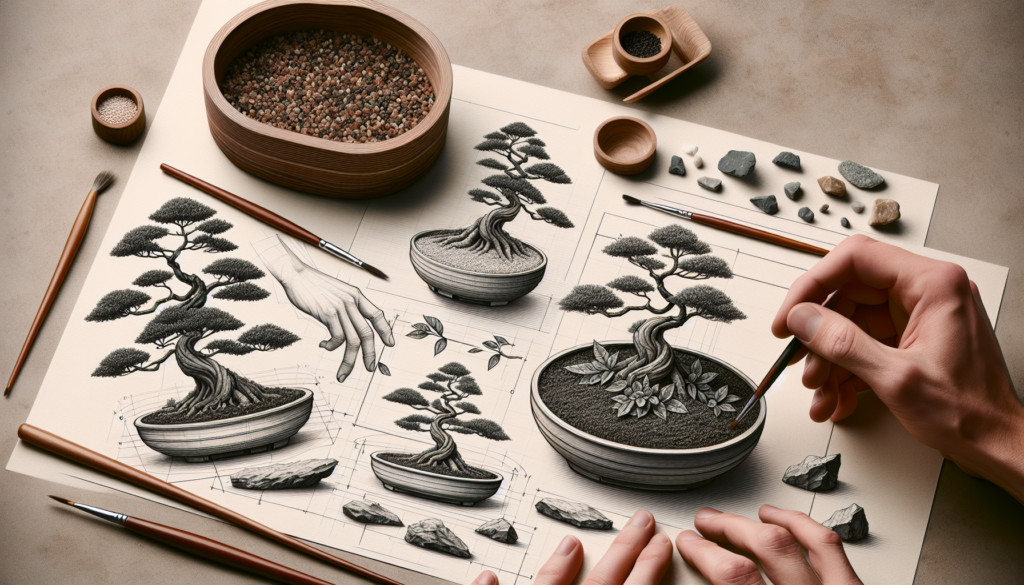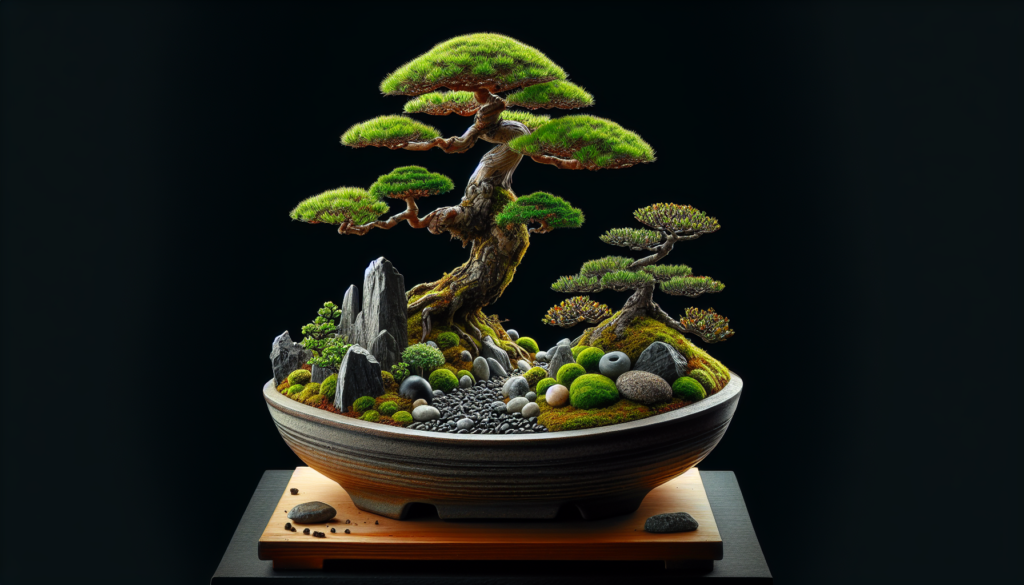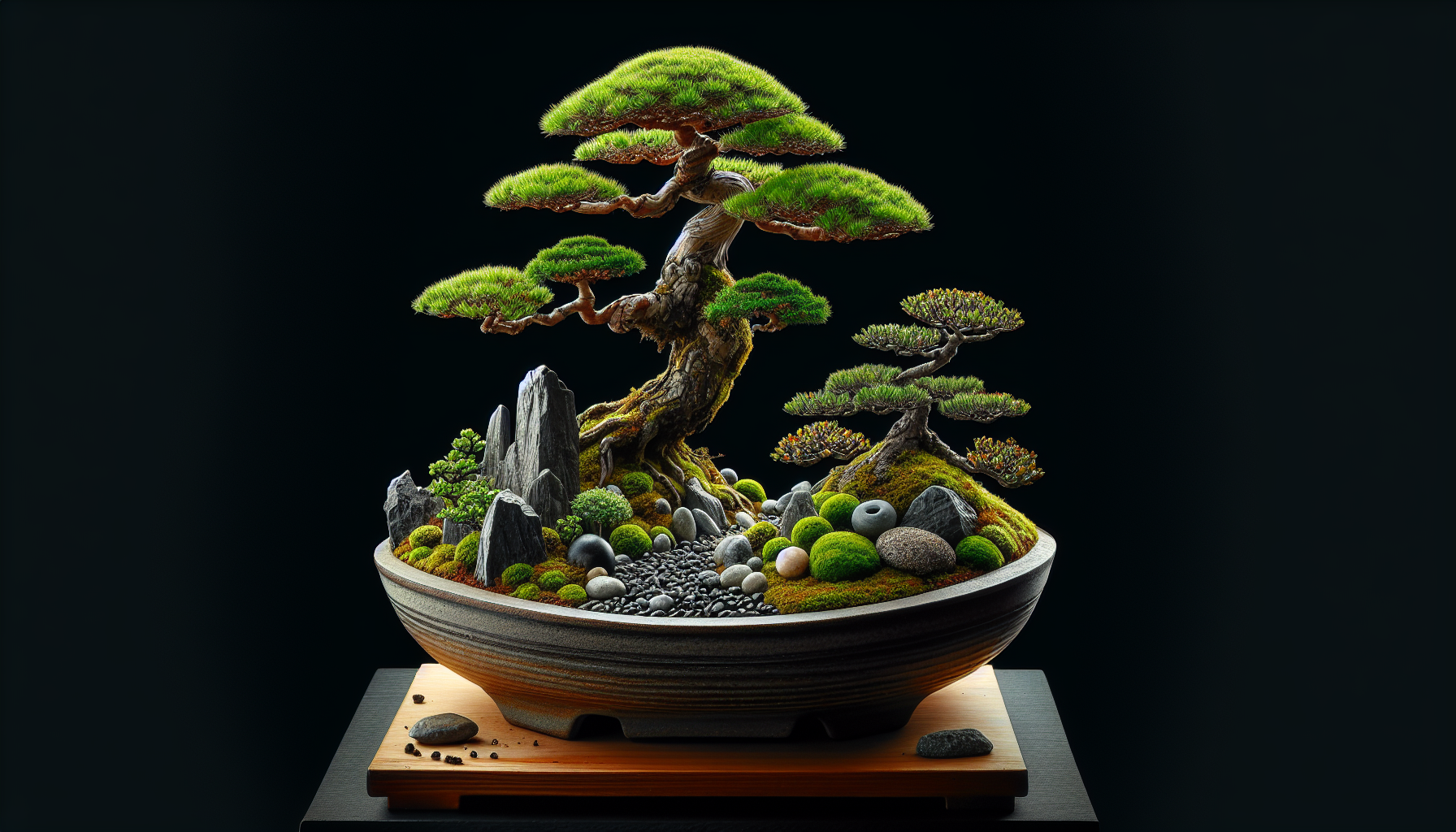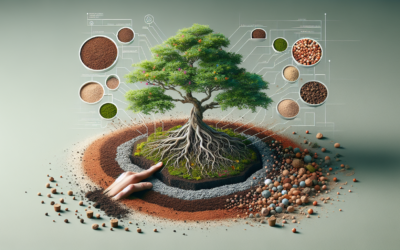You’re passionate about bonsai and have spent countless hours nurturing and shaping your beautiful miniature tree. Now, you’re ready to showcase your creation and create an eye-catching bonsai display that will leave others in awe. In this article, we’ll explore some tips and tricks to help you create a visually stunning setting for your bonsai tree, allowing its beauty to truly shine. From selecting the perfect pot to arranging complementary accessories, get ready to learn how to make your bonsai display a captivating centerpiece that will delight both seasoned enthusiasts and curious onlookers.

Understanding the Art of Bonsai Presentation
When it comes to bonsai, the presentation is just as important as the tree itself. The art of bonsai presentation involves carefully arranging and displaying the bonsai tree, pot, and other accessories in a visually appealing and harmonious way. It is a way to showcase the beauty and artistry of the bonsai tree, while also highlighting its unique characteristics. In this article, we will explore the concepts of bonsai artistry, the history of bonsai displays, and the significance of arrangement and design.
Concepts of Bonsai Artistry
The art of bonsai encompasses several key concepts that guide the presentation of the bonsai tree. These concepts include balance, harmony, proportion, and simplicity. The goal of bonsai artistry is to create a visually pleasing composition that reflects the beauty of nature in a miniature form. By applying these concepts, bonsai enthusiasts can transform a simple tree into a work of art.
History of Bonsai Displays
Bonsai displays have a rich history that dates back thousands of years. Originating in China and later developed in Japan, bonsai has evolved into a sophisticated art form. In ancient times, bonsai trees were displayed in imperial palaces and temples, and were reserved for the elite. Over the centuries, the tradition of bonsai display has spread to other parts of the world, where it continues to captivate and inspire people.
Significance of Arrangement and Design
Arrangement and design play a crucial role in bonsai presentation. Every element in the display, including the bonsai tree, pot, stand, and accessories, must be carefully selected and arranged to create a harmonious composition. The arrangement should reflect the natural growth patterns of the tree, while also considering principles of balance and proportion. By paying attention to these details, bonsai enthusiasts can create a captivating and aesthetically pleasing display.
Choosing the Right Type of Bonsai
Choosing the right type of bonsai is essential in creating a captivating display. Each bonsai species has its own unique characteristics, growth patterns, and requirements. When selecting a bonsai for display, it is important to consider factors such as the size, shape, and age of the tree. Additionally, it is crucial to understand the relationship between bonsai species and different display styles.
Considerations when Selecting a Bonsai
When selecting a bonsai for display, there are several considerations to keep in mind. First, consider the size of the bonsai tree in relation to the display space. A large and imposing tree may overpower a small display area, while a small tree may get lost in a large space. Additionally, consider the shape and style of the bonsai tree, as well as its age and maturity. These factors will influence the overall visual impact of the display.
Popular Bonsai Species for Display
There are numerous bonsai species that are popular for display. Some of the most commonly used species include the Japanese maple, pine, juniper, ficus, and azalea. Each species has its own unique characteristics and growth patterns, which can be showcased in different types of displays. For example, the delicate foliage of a Japanese maple can be highlighted in a minimalist display, while the twisted and gnarled branches of a juniper can be showcased in a more dramatic and dynamic display.
Understanding the Relationship between Bonsai Species and Display Styles
The selection of bonsai species is closely related to the desired display style. Different bonsai species lend themselves well to specific display styles, such as formal upright, informal upright, and cascade. For example, the elegant and symmetrical growth pattern of a Japanese maple is often displayed in a formal upright style, while the cascading branches of a juniper are best showcased in a cascade style. Understanding the relationship between bonsai species and display styles is crucial in creating a visually appealing and cohesive display.
Choosing the Appropriate Bonsai Pot
selecting the right bonsai pot is an important consideration in the overall presentation of the bonsai. The pot should not only provide a suitable environment for the tree’s roots, but also enhance the overall aesthetics of the display. Factors such as size, shape, material, and color should be taken into account when choosing a bonsai pot.
Factors to be Considered when Choosing a Bonsai Pot
When selecting a bonsai pot, there are several factors to consider. First, consider the size of the pot in relation to the size of the bonsai tree. The pot should be proportionate to the tree, neither too large nor too small. Additionally, consider the shape of the pot. A round pot can create a sense of harmony, while a rectangular pot can add a sense of stability and structure. Lastly, consider the material and color of the pot, as these can greatly influence the overall aesthetics of the display.
Relationship between Pot Design and Bonsai Style
The design of the bonsai pot should complement the style of the bonsai tree and the overall display. A formal upright bonsai may be paired with a simple and elegant pot, while a cascading bonsai may be placed in a more elaborate and decorative pot. The shape, color, and texture of the pot should harmonize with the tree and other elements in the display, creating a cohesive and visually pleasing composition.
Materials and Colors of Bonsai Pots
Bonsai pots are available in a variety of materials, including clay, ceramic, and plastic. Each material has its own unique characteristics and advantages. Clay pots, for example, provide good drainage and help regulate moisture levels, while ceramic pots offer more design options and can enhance the beauty of the display. When choosing a pot, consider the color as well. Earth tones such as browns, greens, and blues are often preferred as they blend well with the natural elements of the bonsai tree.
Placement of Bonsai within the Display
The placement of the bonsai within the display is critical in creating a visually appealing and balanced composition. There are certain rules and guidelines that bonsai enthusiasts follow when it comes to the placement of the tree, pot, and other elements in the display. By understanding these principles, you can achieve balance and harmony in your bonsai presentation.
Basic Rules of Bonsai Placement
When arranging a bonsai display, there are a few basic rules to keep in mind. First, consider the placement of the bonsai tree within the display area. The tree should be positioned slightly off-center, creating a sense of movement and organic asymmetry. Additionally, consider the placement of the pot within the display. It should be positioned in a way that complements the natural flow and movement of the tree. Lastly, consider the placement of other elements, such as display stands and accessories, to create a visually balanced and harmonious composition.
How to Achieve Balance in the Display
Balance is a key principle in bonsai presentation. It involves arranging the elements of the display in a way that creates a sense of equilibrium and visual harmony. Balance can be achieved through the careful placement of the bonsai tree, pot, and other elements. For example, if the tree is leaning slightly to one side, the pot can be placed in a way that counterbalances the tilt. Similarly, the placement of accessories, such as stones or figurines, can contribute to the overall balance and aesthetics of the display.
Impact of Bonsai Orientation and Positioning on Visual Appeal
The orientation and positioning of the bonsai tree can greatly impact its visual appeal. The tree should be positioned in a way that allows viewers to appreciate its unique characteristics, such as the trunk, branches, and foliage. When choosing the orientation of the tree, consider its front view, which is often referred to as the “front side” or “front face.” This is the side of the tree that provides the best overall view and aesthetic appeal. Additionally, consider the positioning of the tree within the display to highlight its best features and create a visually appealing composition.

Creating the Bonsai Display Stand
Display stands play a crucial role in bonsai presentation, as they elevate and showcase the bonsai tree and pot. A well-designed display stand can enhance the overall aesthetics of the display and create a sense of elegance and sophistication. In this section, we will explore the role of display stands in bonsai presentation, the different material choices available, and how to design a stand that compliments the tree and pot.
Role of Display Stands in Bonsai Presentation
Display stands serve as a pedestal for the bonsai tree and pot, elevating them to a level where they can be easily seen and admired. They not only add height and dimension to the display, but also provide a sense of stability and structure. Display stands can be made of wood, metal, or other materials, and come in various designs and styles to suit different display themes and aesthetic preferences.
Material Choices for Bonsai Stands
When choosing a material for your bonsai display stand, consider factors such as durability, aesthetics, and overall theme of the display. Wood is a popular choice for display stands due to its natural beauty and versatility. It can be stained or painted to match the color scheme of the display, and can be carved or shaped into intricate designs. Metal stands, such as wrought iron or stainless steel, offer a more contemporary and sleek look, and are often used in modern or minimalist displays.
Designing a Bonsai Stand that Compliments the Tree and Pot
When designing a bonsai stand, it is important to consider the overall aesthetics of the display and the relationship between the stand, tree, and pot. The design of the stand should compliment the style and characteristics of the bonsai tree, as well as the shape and color of the pot. For example, a stand with clean lines and a minimalist design may be the perfect compliment to a formal upright bonsai displayed in a simple and elegant pot. The stand should enhance the overall visual impact of the display, without overpowering or distracting from the main focal point – the bonsai tree.
Incorporating Display Accessories
Display accessories are an important element of bonsai presentation. They add interest, depth, and visual appeal to the display, while also enhancing the overall theme or storyline. In this section, we will explore the importance of bonsai accessories, the appropriate use of bonsai scenery stones, and how to select and display bonsai scrolls.
Importance of Bonsai Accessories
Bonsai accessories play a crucial role in creating a captivating and dynamic display. They can add a sense of realism, natural beauty, and visual interest to the overall composition. Accessories can include elements such as rocks, stones, moss, figurines, or even miniature structures. By carefully selecting and placing these accessories, bonsai enthusiasts can create a narrative or evoke a specific mood or theme in their displays.
Appropriate Use of Bonsai Scenery Stones
Bonsai scenery stones are a popular accessory used in bonsai displays, as they add a sense of natural beauty and serenity to the composition. These stones can represent mountains, cliffs, or other geological formations, and are often placed strategically to enhance the overall aesthetics of the display. When using bonsai scenery stones, it is important to consider their size, shape, color, and texture, as well as their relationship to the bonsai tree and pot. By placing the stones in a way that complements the natural flow and movement of the tree, bonsai enthusiasts can create a visually stunning and harmonious display.
Selecting and Displaying Bonsai Scrolls
Bonsai scrolls, also known as kakejiku, are another accessory commonly used in bonsai displays. These scrolls feature traditional calligraphy or paintings that often depict natural landscapes or seasonal themes. When selecting a bonsai scroll, consider its size, color, and design, as well as how it complements the overall composition and theme of the display. Scrolls should be displayed in a way that allows them to be easily seen and appreciated, without overpowering or distracting from the bonsai tree.
Maintaining the Aesthetic of the Bonsai Display
To ensure the longevity and attractiveness of a bonsai display, regular maintenance is necessary. This involves pruning and shaping the bonsai tree, keeping the bonsai pot clean, and ensuring that the tree remains healthy and vigorous. In this section, we will explore the importance of regular pruning and shaping, how to keep the bonsai pot clean, and the importance of maintaining a healthy bonsai tree for an attractive display.
Regular Pruning and Shaping of Bonsai
Regular pruning and shaping are essential in maintaining the aesthetic appeal and health of the bonsai tree. Pruning helps to control the size and shape of the tree, promote denser foliage growth, and enhance the overall aesthetics of the tree. Shaping, on the other hand, involves training the branches and foliage to create the desired form and style. By regularly pruning and shaping the bonsai tree, bonsai enthusiasts can keep it in proportion to the display, and create a visually balanced and harmonious composition.
Keeping the Bonsai Pot Clean
A clean bonsai pot is important in maintaining the aesthetics of the display. Over time, the pot can accumulate dirt, algae, or lichen, which can detract from the overall visual appeal of the bonsai tree. To keep the pot clean, gently remove any debris or dirt using a soft brush or cloth. Avoid using harsh chemicals or abrasive materials that may damage the pot. Regular maintenance and cleaning will ensure that the bonsai pot remains in pristine condition and enhances the overall beauty of the display.
Maintain a Healthy Bonsai for an Attractive Display
A healthy bonsai tree is the foundation of an attractive display. It is important to provide the tree with the proper care and maintenance it needs to thrive. This includes watering the tree regularly, providing the appropriate amount of sunlight, and fertilizing as needed. Additionally, monitoring the tree for any signs of pests or diseases and taking appropriate action is crucial. By maintaining the health of the bonsai tree, bonsai enthusiasts can ensure that it continues to thrive and contribute to the overall beauty of the display.
Adjusting the Display for Seasons and Special Occasions
Bonsai displays can be adapted and adjusted to suit different seasons and special occasions. By incorporating seasonal themes, festival-themed displays, or creating displays for bonsai competitions or exhibitions, bonsai enthusiasts can create a display that is not only visually appealing, but also meaningful and engaging.
Seasonal Themes for Bonsai Displays
One way to enhance the visual appeal of a bonsai display is to incorporate seasonal themes. This involves selecting bonsai trees, pots, and accessories that represent the colors, textures, and characteristics of a particular season. For example, in the spring, you may choose a bonsai tree with vibrant blossoms and fresh green foliage, and pair it with accessories that mimic the awakening of nature. In the fall, you may select a bonsai tree with fiery red or golden leaves, and incorporate accessories that evoke the mood and beauty of the season.
Festival-Themed Bonsai Display Ideas
Festivals provide an excellent opportunity to create unique and festive bonsai displays. Whether it’s celebrating the arrival of spring, honoring a cultural event, or marking a special occasion, festival-themed displays can be visually striking and captivating. For example, during the Lunar New Year, a bonsai display featuring cherry blossoms, red accessories, and decorative lanterns can create a festive and joyful atmosphere. Similarly, for Halloween, a display of spooky-looking bonsai trees, accompanied by themed accessories, can add a touch of mystery and intrigue.
Making a Display for a Bonsai Competition or Exhibition
Bonsai competitions and exhibitions are a great platform to showcase your artistic skills and creativity. When creating a display for such events, it is important to consider the rules and guidelines set by the organizers. The display should not only showcase the bonsai tree, but also demonstrate your mastery of arrangement, design, and composition. Attention to detail, aesthetics, and the overall impact of the display are key factors to consider. By carefully planning and executing your bonsai display, you can create a visually stunning and memorable presentation that impresses judges and spectators alike.
Lighting and Photography of the Bonsai Display
Proper lighting and photography techniques are essential in capturing the beauty and essence of a bonsai display. Whether it’s using natural light to highlight the unique characteristics of the tree or employing specialized techniques to photograph the intricacies of the display, lighting plays a crucial role in enhancing the visual appeal of bonsai.
Use of Natural Light in Bonsai Display
Natural light can be a powerful tool in highlighting the beauty and intricacies of a bonsai display. By positioning the display in an area that receives ample sunlight, the natural light can accentuate the textures, colors, and details of the bonsai tree and accessories. It is important to be mindful of the intensity and direction of the light, as well as any potential shadows that may detract from the overall aesthetics of the display. Experimentation and observation are key in harnessing the natural light to create a visually captivating and dynamic bonsai presentation.
Techniques for Photographing a Bonsai Display
Photographing a bonsai display requires careful consideration of composition, lighting, and perspective. To capture the beauty and essence of the display, it is important to position the camera at the appropriate angle, focusing on the main elements of interest. Experiment with different camera settings, such as aperture and shutter speed, to create the desired effects. Additionally, consider using a tripod to minimize shake and ensure crisp, clear images. By employing these techniques, you can capture stunning photographs that do justice to the artistry and aesthetics of your bonsai display.
Role of Lighting in Highlighting Bonsai Features
Lighting plays a crucial role in highlighting the unique features and characteristics of a bonsai display. Artificial lighting, such as spotlights or track lights, can be used to selectively illuminate certain areas of the display, drawing attention to specific elements or creating a particular mood. By strategically placing lights at various angles and intensities, you can create depth, shadows, and highlights that accentuate the beauty and artistry of the bonsai tree and other components of the display. Experimentation and creativity are key in using lighting to enhance the visual appeal and impact of the bonsai presentation.
Bonsai Display Etiquette
Bonsai display etiquette is an important aspect of the bonsai enthusiast community. It involves adhering to certain rules and guidelines when it comes to displaying, viewing, and caring for bonsai. By practicing proper bonsai display etiquette, you demonstrate respect and appreciation for the artistry and effort that goes into creating and maintaining a bonsai display.
General Rules for Bonsai Display
When it comes to bonsai display, there are a few general rules to keep in mind. First and foremost, handle the bonsai tree and other elements of the display with care and respect. Avoid touching or handling the tree unnecessarily, as this can damage the foliage or disturb the overall composition. Secondly, maintain cleanliness and tidiness in the display area. Remove any fallen leaves, debris, or dead branches to ensure a visually appealing and well-maintained display. Lastly, observe any specific rules or guidelines set by the organizers or hosts, particularly when it comes to bonsai competitions or exhibitions.
Etiquette for Viewing Bonsai Displays
When viewing a bonsai display, it is important to be respectful and considerate of the bonsai tree and other viewers. Avoid touching or leaning on the display, as this can cause damage or disrupt the arrangement. Observe the display from various angles and perspectives to fully appreciate the artistry and craftsmanship. Additionally, refrain from making loud noises or disturbing the peaceful atmosphere of the display area. By following proper etiquette, you can contribute to a positive and enjoyable experience for all bonsai enthusiasts.
Proper Care and Respect for Displayed Bonsai
If you are the caretaker of a displayed bonsai, it is important to provide the proper care and respect it deserves. Regularly water the tree as needed, taking care not to overwater or underwater. Monitor the tree for any signs of pests or diseases, and take appropriate action to address these issues. Additionally, ensure that the tree receives the appropriate amount of sunlight and is positioned in a suitable location within the display. By demonstrating care and respect for the bonsai tree, you contribute to the overall aesthetics and longevity of the display.
In conclusion, the art of bonsai presentation is a captivating and intricate endeavor. From understanding the concepts of bonsai artistry to selecting the right bonsai species, pot, and accessories, each element has a significant impact on the overall aesthetic appeal of the display. By adhering to proper bonsai display etiquette and maintaining the health of the tree, you can create an eye-catching bonsai display that not only showcases the beauty of nature, but also pays tribute to the artistry and craftsmanship of bonsai. So, take the time to explore and experiment with the various aspects of bonsai presentation, and let your creativity and passion shine through in your own unique bonsai displays.








